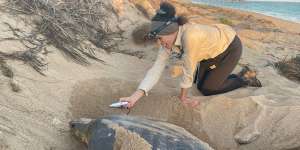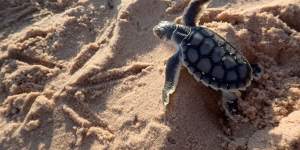Currently,76 cent of eggs results in a hatchling emerging on the surface;but this would drop to 63 per cent at two degrees of global warming and plummet to just 37 per cent at four degrees,shows research co-authored by University of Western Australia Associate Professor Nicki Mitchell.
“They are a special one because they’re Australia’s sea turtle,no other country can say that they’ve got a unique sea turtle species,” said Mitchell,who is deputy director of the university’s Oceans Institute and has studied flatbacks extensively.

Lead researcher Dr Malindi Gammon scanning a flatback turtle for a microchip identification tag.Malindi Gammon,DBCA
Global warming will also herald a change of gender mix,as the temperature of the sand in the middle of a flatback’s 55 day-incubation period determines if the hatchlings’ gonads develop into testes or ovaries.
The predicted change in gender mix was studied across the 402 known nesting beaches in the Pilbara. One of the coolest beaches studied,on Thevenard Island,was predicted to swing from producing 90 per cent males to 32 per cent even at two degrees of warming.
One of seven marine turtle species,they extend from the Pilbara across the top of Australia to southern Queensland. The research by the university and the state’s Department of Biodiversity,Conservation and Attraction just considered the Pilbara stock,which does not interbreed with the Kimberley stock to the north.
Females breed every two or three years over summer and visit a beach,normally the one they were born on,up to four times to lay clutches of eggs. They mate between each visit,often with multiple males.
Mitchell said the species’ promiscuity made it less vulnerable to a reduction in the number of males compared to species that mated for life.
But the effects of climate change on the chance of an egg resulting in a hatchling made protection of their nesting sites important.
Mitchell said people affected turtle nesting sites in many ways. Four-wheel driving compacted beach sand,making it harder for hatchlings to dig to the surface. Nearby lights could cause the hatchlings to head in the wrong direction. Pollutants and changes to the shape of the beach caused problems,as did foxes on mainland beaches.
Island nesting sites were important,she said,as they were fox-free and generally cooler than mainland sites.

Female hatchlings can grow to weigh between 50kg and 125kg.James Gee,DBCA.
The need for cooler nesting sites makes beaches at the southern end of the country’s North West Shelf,flatback turtles’ nesting range,increasingly important – including islands in the Exmouth Gulf midway along the state’s coastline,neighbouring the World Heritage Site of Ningaloo.
German company K+S Salt wants to produce 3.5 million tonnes of salt a year from a site inland from the eastern coast of the Gulf,40 kilometres from Onslow. In March environmental group calling for the plan to be dropped.
In 2021,the WA government committed to establish a marine park in the southern and eastern parts of the Gulf.
Start the day with a summary of the day’s most important and interesting stories,analysis and insights..